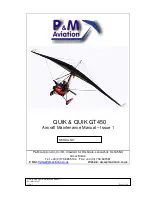
DAVINCI GLIDERS / TANGO
9
11.5 Asymmetrical stall
11.6 B stall
It can take place when you pull one of the brakes too hard, or while spiraling
at a small speed in turbulence you increase the angle of attack. Rotation in the
asymmetrical stall is called negative spiral. This is one of the most dangerous
flying situations. In order to get out of asymmetrical stall, just release the
brakes. There may follow side thrust forward with a following wing collapse.
The TANGO has a very clean stable B stall. To enter the B stall, the pilot has to pull the
first 20cm slowly until the r glider loses forward speed and starts to descend at around
6 m/s vertically. Do not release the brake handles during B stall. If you pull too much
B-line the glider may horseshoe and move around a lot. If this happens, release the B
risers.
To exit the B-stall the B-risers should be released symmetrically and in one
smooth, progressive motion. The glider will resume normal forward flight
without further input. Check you have forward flight again before using the
brakes.
11.4 Deep stall
11.3 Full stall
It is possible for gliders to enter a state of deep stall. This can be caused by
several situations including; a very slow release from a B-line stall; flying the
glider when wet; very old glider; or after a front/symmetric deflation.
When you meet this situation you should fully raise up the both brakes and
push the A-risers forwards or use the speed bar symmetrically to regain
normal flight.
Full stall can occur when you fully pull the both brakes enough long time. This
means that the wing loses its forward momentum. To recover to the normal
flight you must release both brakes. After this usually comes a front dive
with a possible front deflation. An asymmetric recovery (one control released
faster than the other) from a full-stall can cause a big dynamic collapse. The
full-stall is a hazardous manoeuvre and as such outside the scope of this
manual. You should practice and learn this manoeuvre only on a SIV course
under professional instructor.







































